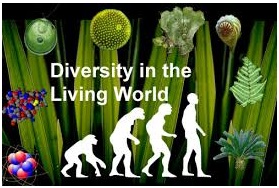Learninsta presents the core concepts of Biology with high-quality research papers and topical review articles.
Diversity in the Living World
Earth has numerous habitats with a wide range of living organisms inhabiting them. Plants and animals are present in almost all the places, from polar icecaps to volcanic hot springs, from shallow lagoons to the deepest oceans, from tropical rain forests to dry and parched deserts. There are a variety of species that have been adapted successfully to live in diverse ecosystems.
Ecosystem is a community of biotic and a biotic factors and their interrelationships (A.G. Tansley, 1935). The presence of a large number of species in a particular ecosystem is called ‘biological diversity’ or in short ‘biodiversity’. The term biodiversity was first introduced by Walter Rosen (1985), and defined by E.D. Wilson.
Characterstic Features of Living Organisms
Living organisms show a variety of unique characters different from nonliving matter. The key characters of living organisms are, cellular organization, nutrition, respiration, metabolism, growth, response to stimuli, movement, reproduction, excretion, adaptation and homeostasis.
Numerous scientists and taxonomists have made tremendous contribution and documentation in the observation and study of even minute characters in living organisms. Their keen observations have led to the classification of living organisms and the study of their interrelationships.
Increase in mass and increase in number of individuals are essential criterion for the growth of the living organism. Growth of multicellular organisms occurs due to cell division. Reproduction is another characteristic of living organisms. Metabolism is another characteristic of living organisms.
Diverse form of living organisms are found in different types of habitats like ocean, fresh water bodies, forests, cold mountains, deserts, hot water springs etc.
Biodiversity is the variation of life forms, within a given ecosystem, biome or for the entire earth. It is a combination of two words; bio meaning life and diversity meaning variety. It refers to the varieties of plants,
animals and micro-organisms, the genes they contain and the ecosystems they form.
It means understanding that each individual is unique, and recognizing our individual differences. These can be along the dimensions of race, ethnicity, gender, sexual orientation, socio-economic status, age, physical abilities, religious beliefs, political beliefs, or other ideologies.
‘Living’ is something that is alive, something that can grow, move, reproduce, respire and carry out various cellular activities.
Diversity gives you access to a greater range of talent, not just the talent that belongs to a particular world-view or ethnicity or some other restricting definition. It helps provide insight into the needs and motivations of all of your client or customer base, rather than just a small part of it.
The term biodiversity (from “biological diversity”) refers to the variety of life on Earth at all its levels, from genes to ecosystems, and can encompass the evolutionary, ecological, and cultural processes that sustain life.
